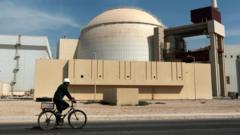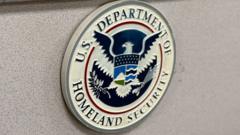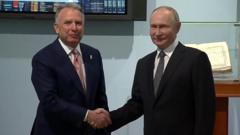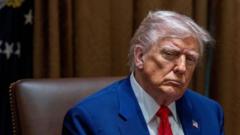The recent tit-for-tat tariff increases between the U.S. and China have heightened fears of an economic downturn, with agricultural sectors particularly concerned about loss of market access. Both nations aim to communicate stronger trade positions, yet the consequences could render economic chaos.**
U.S.-China Trade War Escalates with New Tariff Increases**

U.S.-China Trade War Escalates with New Tariff Increases**
Rising tensions between the U.S. and China as both countries impose record tariffs on each other's goods, provoking market volatility and economic uncertainty.**
The ongoing trade war between the United States and China escalated as both nations have raised their tariffs to unprecedented levels in a swelling tit-for-tat conflict that is unsettling global markets and heightening fears of a potential economic downturn. On April 11, the U.S. government announced increased tariffs on Chinese goods to a staggering 145%, following similar retaliatory actions from China, which raised their tariffs on American imports to 125%, effective the next day.
President Trump's administration has seen an aggressive push to impose tariffs beyond what had previously been in place, aiming to bolster U.S. economic strength while simultaneously pressuring Beijing. The latest escalation came shortly after the White House confirmed that tariffs for many Chinese goods would now face a floor rate of 145%, up from earlier rates of 84%. This back-and-forth retaliatory cycle has prompted immediate implications for stock markets worldwide, already on edge due to the rapidly changing landscape of U.S. trade policy.
Concerns now loom large for U.S. farmers, particularly those in politically pivotal red states, as the Chinese tariffs potentially cut them off from their single-largest export market. Describing the turmoil, Caleb Ragland, president of the American Soybean Association, voiced fears that a lengthy confrontation over trade could lead to dire economic situations, rendering some farmers unable to sustain operations.
Consumer Markets and Technology industries are caught in a web of uncertainty as they navigate unpredictable costs and strained supply chains. Economists warn that the consequences of intensified tariffs on American goods may ripple down through the economy, pushing up prices on everyday products and further straining inflation already being faced by both large retailers and small businesses alike.
In a broader strategic assessment, the sweeping imposition of tariffs could see both U.S. and China looking to cut forth on negotiations. While Trump has framed these tariffs as leveraging positions to procure better trade deals, economists express skepticism about the effectiveness of tariffs in achieving these goals. The potential for long-standing ramifications on communities along with local economies struggling under the weight of these abrupt trade policies remains a matter of urgent concern.
With stock markets experiencing turbulent fluctuations—characterized by sudden surges followed by steep declines—the impact of tariffs on investor confidence becomes clearer. The VIX index, a commonly accepted measure of market volatility, has reached levels reminiscent of earlier economic crises, underscoring investor apprehension about the imminent fallout from this escalating trade war.
Despite assurances from the Trump administration regarding the anticipated outcomes of shifting trade paradigms, many Republican lawmakers have voiced their anxieties about potential backlash from constituents, especially as they too understand the economic fragility that has resulted from a sharply polarizing trade policy. Both the agricultural sector and technology firms may find themselves forced to adapt quickly to falling demand and changing market conditions if tariffs become a permanent fixture within international trade frameworks.
As the situation continues to develop, stakeholders in both the U.S. and China will be closely monitoring future announcements and policy shifts, hoping for some form of economic resolution that could restore a balance in trans-Pacific trade relations.
President Trump's administration has seen an aggressive push to impose tariffs beyond what had previously been in place, aiming to bolster U.S. economic strength while simultaneously pressuring Beijing. The latest escalation came shortly after the White House confirmed that tariffs for many Chinese goods would now face a floor rate of 145%, up from earlier rates of 84%. This back-and-forth retaliatory cycle has prompted immediate implications for stock markets worldwide, already on edge due to the rapidly changing landscape of U.S. trade policy.
Concerns now loom large for U.S. farmers, particularly those in politically pivotal red states, as the Chinese tariffs potentially cut them off from their single-largest export market. Describing the turmoil, Caleb Ragland, president of the American Soybean Association, voiced fears that a lengthy confrontation over trade could lead to dire economic situations, rendering some farmers unable to sustain operations.
Consumer Markets and Technology industries are caught in a web of uncertainty as they navigate unpredictable costs and strained supply chains. Economists warn that the consequences of intensified tariffs on American goods may ripple down through the economy, pushing up prices on everyday products and further straining inflation already being faced by both large retailers and small businesses alike.
In a broader strategic assessment, the sweeping imposition of tariffs could see both U.S. and China looking to cut forth on negotiations. While Trump has framed these tariffs as leveraging positions to procure better trade deals, economists express skepticism about the effectiveness of tariffs in achieving these goals. The potential for long-standing ramifications on communities along with local economies struggling under the weight of these abrupt trade policies remains a matter of urgent concern.
With stock markets experiencing turbulent fluctuations—characterized by sudden surges followed by steep declines—the impact of tariffs on investor confidence becomes clearer. The VIX index, a commonly accepted measure of market volatility, has reached levels reminiscent of earlier economic crises, underscoring investor apprehension about the imminent fallout from this escalating trade war.
Despite assurances from the Trump administration regarding the anticipated outcomes of shifting trade paradigms, many Republican lawmakers have voiced their anxieties about potential backlash from constituents, especially as they too understand the economic fragility that has resulted from a sharply polarizing trade policy. Both the agricultural sector and technology firms may find themselves forced to adapt quickly to falling demand and changing market conditions if tariffs become a permanent fixture within international trade frameworks.
As the situation continues to develop, stakeholders in both the U.S. and China will be closely monitoring future announcements and policy shifts, hoping for some form of economic resolution that could restore a balance in trans-Pacific trade relations.























